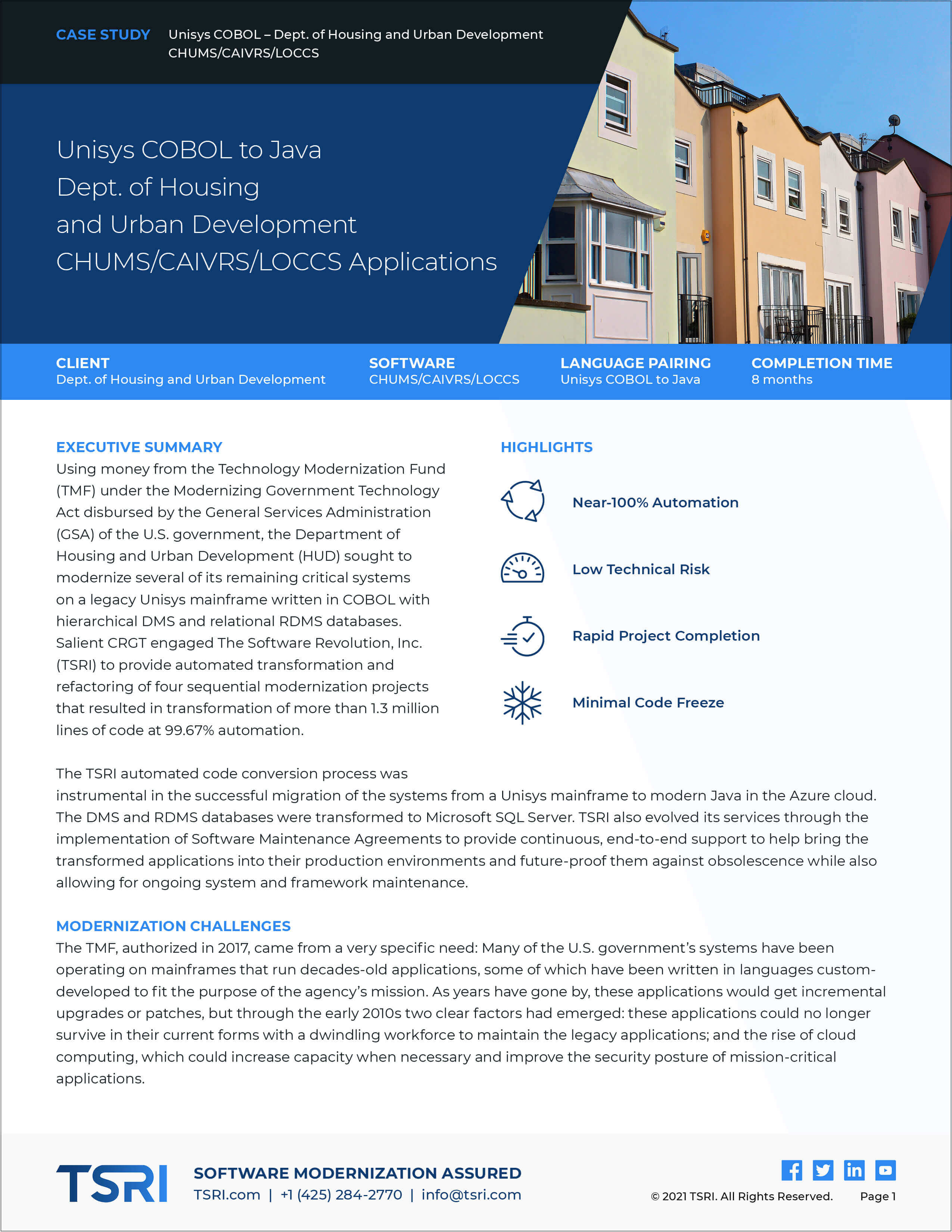Displaying items by tag: Azure Cloud
Press Release: TSRI Completes Four Government Mainframe Modernizations with TMF Funds
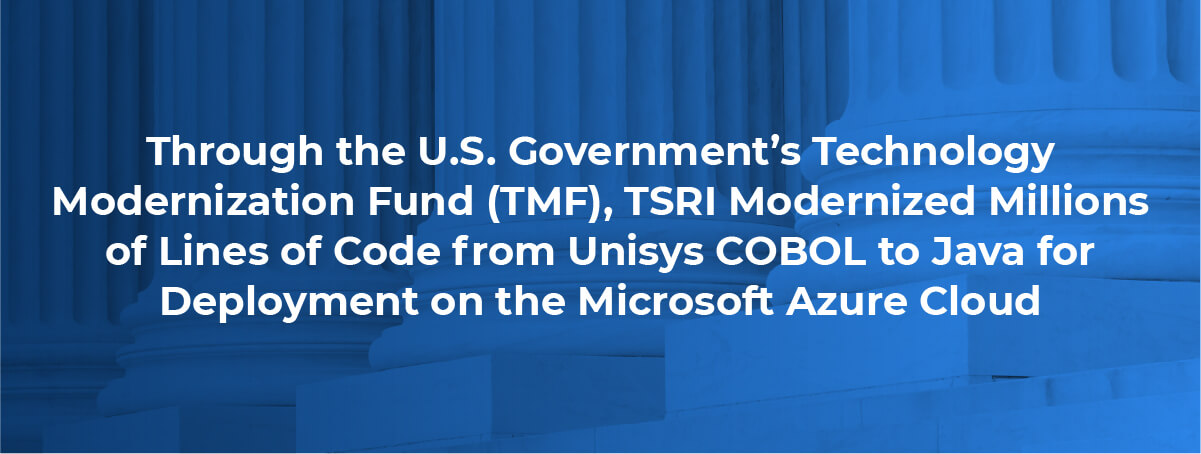
"The successful modernization and cloud deployment of these four critical government applications is proof that the U.S. Technology Modernization Fund is beginning to fulfill its purpose."
Nicolas Newcomb, TSRI President
KIRKLAND, Wash., March 31, 2022 (GLOBE NEWSWIRE) --TSRI, a recognized leader in fully-automated software modernization — announces the recent completion of a large-scale, public sector application modernization and mainframe retirement effort that transformed four critical, aging applications from Unisys COBOL to Java for a United States federal government agency. The federal agency’s applications containing millions of lines of code were modernized over three years and deployed to the Microsoft Azure Cloud.
The effort was the first of its kind to leverage the funds available to government entities via the Modernizing Government Technology (MGT) Act’s Technology Modernization Fund (TMF). With federal government mandates gaining further prominence and the bipartisan bill — the Legacy IT Reduction Act of 2022 — currently on the floor of the U.S. Senate, TSRI is well-positioned to support government entities in modernizing their outdated legacy information technology systems.
Critical and Aging Systems, Transformed for Modern Times
Despite incremental upgrades or patches over the years to this federal agency's decades-old mainframe applications, a dwindling supply of programmers made it increasingly difficult to maintain them. In addition, cloud computing would improve these mission-critical applications' reliability and security. Using TMF funds, this U.S. government entity sought to modernize several of its remaining critical systems on a legacy Unisys mainframe. TSRI provided automated code conversion of more than 1.3 million lines of the client's COBOL applications, with hierarchical DMS and relational RDMS databases, to the Microsoft Azure cloud. TSRI implemented Java as the target language and Microsoft SQL Server as the target relational database at 99.67% automation levels.
On day one after the production systems were switched over from the Unisys mainframe to the Microsoft Azure cloud, the new system supported 25,356 users and 299,715 transactions with only three user problems reported. These critical systems — responsible for managing, storing, and protecting personal financial and employment-related data for government-supported home financing — were seamlessly deployed to the new Microsoft Azure Cloud environment without impact on operations. The positive results could be seen in the first 30 days during which the new system disbursed billions of dollars in program funds to eligible users without a single error.
“The successful modernization and cloud deployment of these four critical government applications is proof that the U.S. Technology Modernization Fund (TMF) is beginning to fulfill its purpose,” TSRI President, Nicolas Newcomb, said. “This federal agency’s crucial technology now serves people more predictably and reliably while providing efficiency and cost-savings for the government and therefore, Americans. Furthermore, these applications can now be more effectively maintained and evolved now and in the future.”
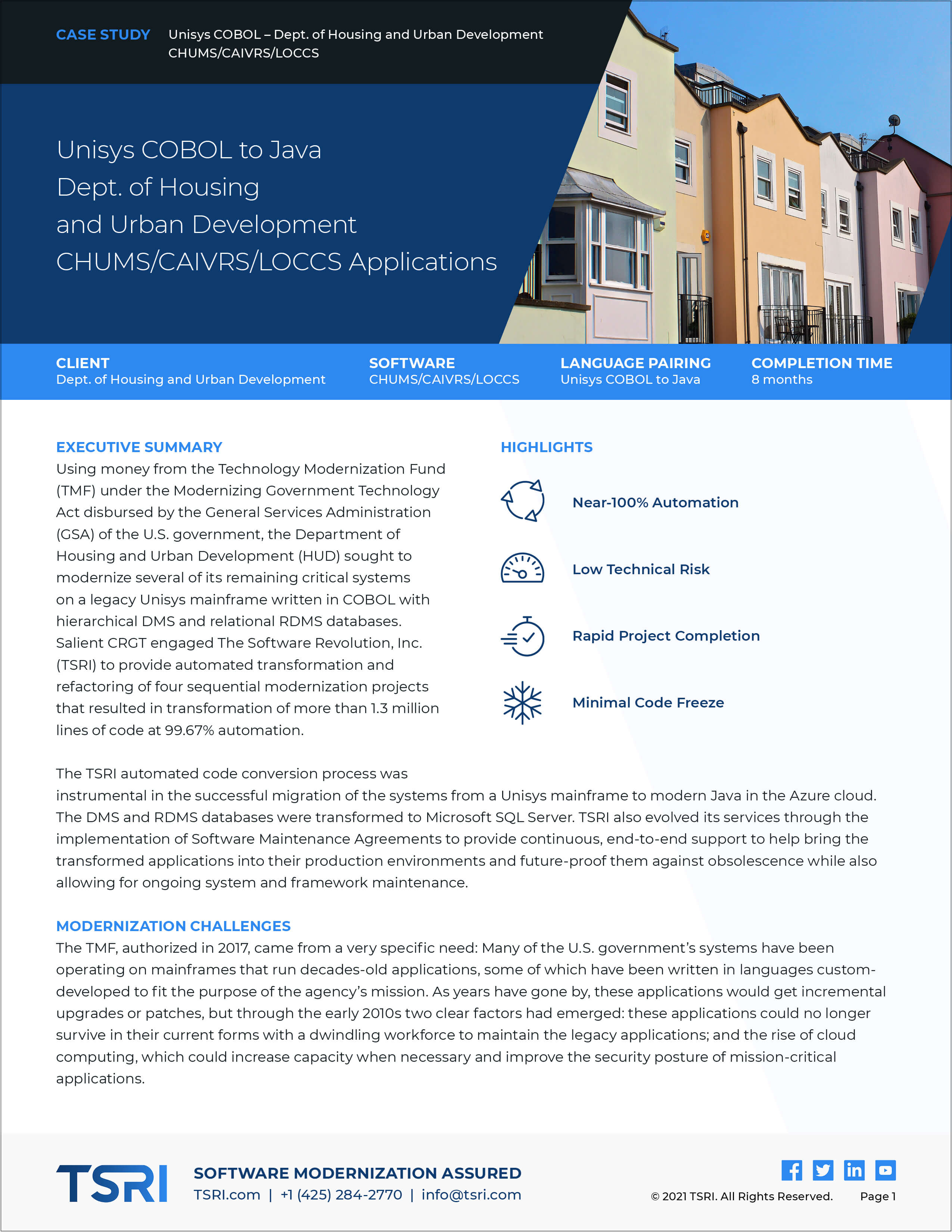 View the case study for more details on this government IT modernization project.
View the case study for more details on this government IT modernization project.
For Government Agencies, The Time to Modernize is Now
Four years ago, the United States government established the Technology Modernization Fund to support federal agencies in funding the modernization of their aging information technology infrastructure. On March 23, a bi-partisan bill was introduced to the United States Senate: The Legacy IT Reduction Act of 2022. The bill aims to make the modernization of federal legacy IT systems mandatory.
“Every year, the number of programmers required to maintain or improve the legacy systems we all rely on shrinks but that doesn’t mean we depend on those systems any less,” TSRI’s Nicolas Newcomb said. “We can say that this one federal agency’s crucial technology is now serving the American people more predictably and reliably, but there are still thousands of crucial, at-risk applications that we rely on to conduct our daily lives and business. We have never previously witnessed the scale and severity of technology obsolescence we may currently face.”
Nicolas continued: “TSRI can reliably and rapidly modernize — and frequently improve —these carefully designed systems. Cloud architectures offer predictable landing zones, and the sophistication of the foundational technologies have made modernizations more seamless than ever. Done well, a modernization accelerates the delivery of benefits to business bottom lines and improves the lives of end-users. Simultaneously, modernizations help relieve the liabilities caused by technical debt and human resource scarcity. In the end, application modernization is organizational modernization. Therefore, TMF funding is a responsible step to ensure our government is competitive, secure, and efficient. There should be no doubt that the time to modernize our crucial software infrastructure applications is indeed now,” he concluded.
TSRI has decades of experience modernizing applications in over 35 legacy languages for public sector, government, and military entities in the U.S. and beyond. Examples include the U.S. Air Force, the U.S. Customs and Border Control, the U.S. Navy, the Canadian Revenue Agency, and the Government of Denmark. View TSRI’s case studies for more.
Today’s modern systems often require deployment to cloud environments. TSRI modernizes applications for deployment to any cloud environment and is a validated Amazon Web Services Mainframe Migration partner.
---
TSRI is Here for You
As a leading provider of software modernization services, TSRI enables technology readiness for the cloud and other modern architecture environments. We bring software applications into the future quickly, accurately, and efficiently with low risk and minimal business disruption, accomplishing in months what would otherwise take years.
TSRI – Software Modernization Assured
See Case Studies
Learn About Our Technology
Get Started on Your Modernization Journey Today!
Video: Modernizing HUD from Unisys Mainframe to Cloud with Roger Knapp
Only a few engineers know how it feels to lead a major government agency through an automated mainframe modernization for multiple applications from COBOL to Java on the Microsoft Azure cloud. TSRI’s Executive Vice President of Engineering & Service Delivery, Roger Knapp, is one of them!
Get the story straight from Roger in his interview with GovCIO about his experiences modernizing multiple applications for the U.S. Department of Housing and Urban Development (HUD).
Also, be sure to check out TSRI’s case study to learn more about our work with GovCIO to transform multiple Mainframe Unisys 2200 COBOL with DMS2200 databases to Java with a factory-style process. The modernized systems were deployed on the Microsoft Azure Cloud and hook directly into the Microsoft Azure DevOps pipeline!
TSRI utilized the same proven JANUS Studio® modernization solution, process, and approach we have leveraged for our other IBM, Tandem, Unisys, and other mainframe modernizations. During the project, TSRI provided “As-Is” and “To-Be” application documentation. We utilized our powerful refactoring engine to improve code quality, maintainability, readability, and security to meet the HUD’s needs. HUD’s modernized applications (CHUMS, F42d/CAIVRS, and LOCCS) are live, in production, and being actively maintained by Java developers.
This program was also the first-ever modernization utilizing the U.S. Technology Modernization Fund (TMF) distributed by the General Services Administration (GSA) and hailed as a resounding success! Maria Roat, the deputy federal chief information officer, shared in a CompTIA webinar that the U.S. government’s technology modernization fund (TMF) is about accelerating projects and enabling multi-year funding.
“HUD mainframe modernization, there’s a playbook coming out of that. So other agencies, they’re going through their mainframe modernization, they can take lessons learned from HUD and apply that,” she said. “As we as we look to scale and accelerate the board, there’s a lot of things that we’ve already done over the last three years, as we’ve matured, that we can apply to the future funding.”
TMF allowed HUD to move off the mainframe completely, get OPEX savings and achieve an amazing reduction in TCO for the Department (80%+ compared to the mainframe TCO).
Download the full case study and learn more.
TSRI is Here for You
As a leading provider of software modernization services, TSRI enables technology readiness for the cloud and other modern architecture environments. We bring software applications into the future quickly, accurately, and efficiently with low risk and minimal business disruption, accomplishing in months what would otherwise take years.
See Case Studies
Learn About Our Technology
Get Started on Your Modernization Journey Today!
Taking a Low-Risk Approach to Mainframe Modernization — HUD
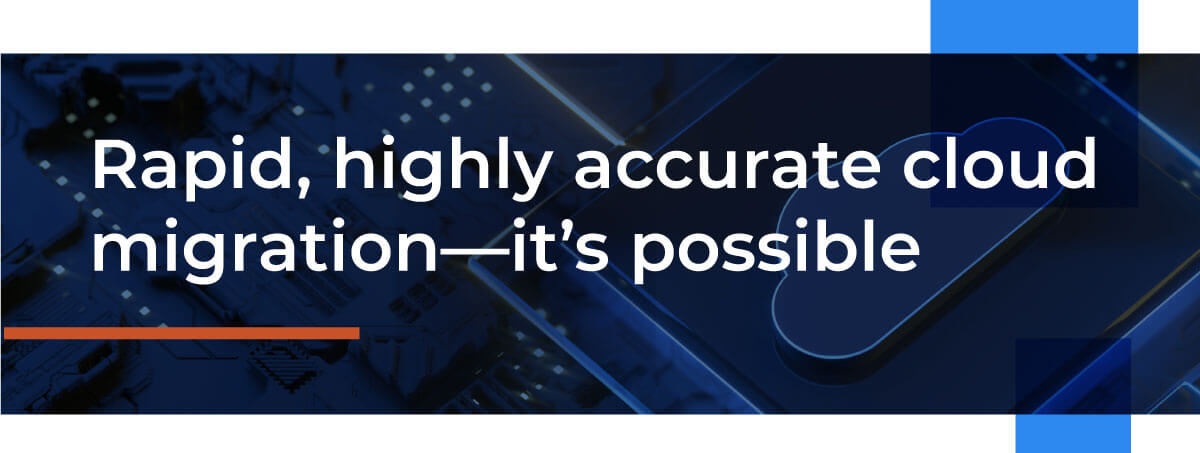
How do you transform the slow pace of technological innovation within a federal agency into an opportunity for innovation and IT systems modernization? Start by taking a cue from the partnership between TSRI and GovCIO. With backing from the Federal Government’s Technology Modernization Fund (TMF) our joint teams propelled the US Department of Housing and Urban Development (HUD) from an outdated twentieth-century Unisys COBOL system into modern, service-oriented Java that was performant and functionally equivalent.
TSRI worked with GovGIO on their process designed to successfully migrate the applications to the Microsoft Azure cloud. They started by defining the five key project goals and taking an inventory of system components, including intersecting platforms. Once we had identified what the unique technical challenges were and how to address each, we created testing strategies and migrated the data stores for each system. Finally, we executed an automated code conversion and refactored the legacy COBOL code.
TSRI’s partnership with GovCIO executed a rapid, holistic mainframe migration process for HUD that has improved their organizational performance while minimizing risk. On day one after the productions systems were switched over from the Unisys mainframe to the Microsoft Azure cloud, the new system supported 25,356 users and 299,715 transactions with only three user problems reported. These are the HUD systems that manage, store, and protect all the personal financial and employment-related eligibility information for FHA insured financing. Given the criticality of the data managed every day by HUD, it was important that the migration run without impact on operations. The result could be seen in the first 30 days during which the new system disbursed just over $2.7 billion dollars in HUD program funds without a single error.
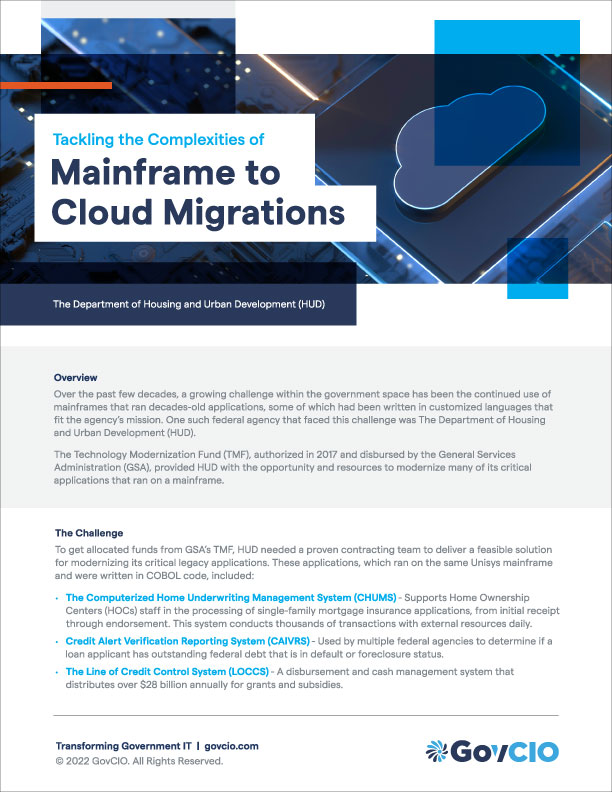 Review the details of how TSRI and GovCIO successfully executed this complex modernization project in our recently published case study.
Review the details of how TSRI and GovCIO successfully executed this complex modernization project in our recently published case study.
The 9 Low-Risk Steps That Led to Success
You might be surprised that HUD and other government agencies still run their IT on mainframes using COBOL (first released in the 1950’s), or MUMPS (from the 1970’s). Running on these aging platforms presents an extensive list of challenges to these agencies: data management, growing storage, collaboration, security, etc. The modernization process typically involves risk, time, and significant expense. It’s understandable that a large agency like HUD would want to select a partner they knew could deliver a low-risk, high-accuracy result.
Working together, we adhered to GovCIO’s nine-step best-practices process that resulted in modernizing systems to modern cloud architectures that can now evolve with HUD, while preventing negative impacts to their mission, day-to-day operations, and security.
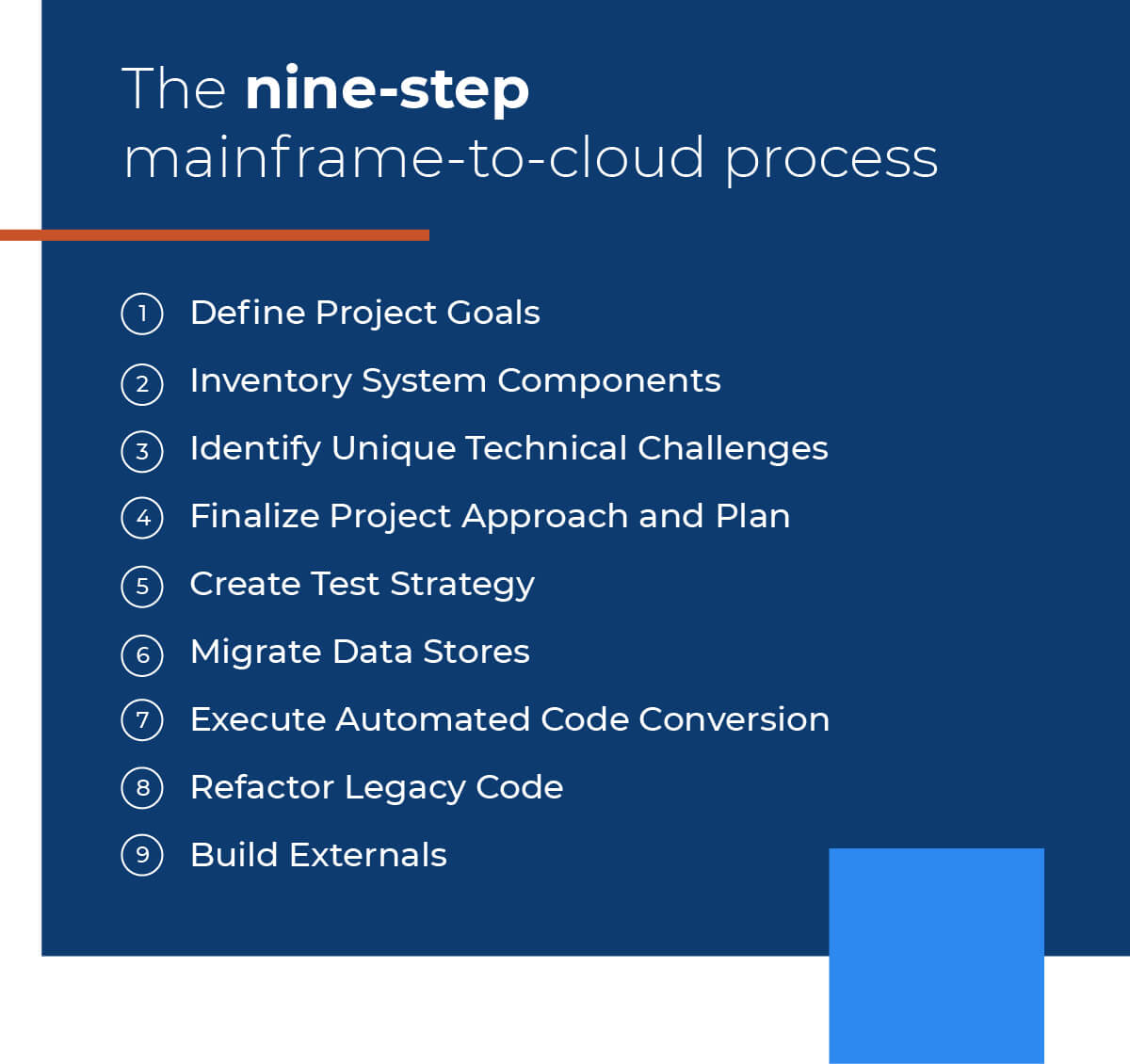
For more details on the nine-step process that enabled HUD to enter the cloud age, read our latest white paper with GovCIO.
A first-person account of HUD’s modernization process with Roger Knapp – Executive Vice President and HUD Program Manager
Only a few engineers know what it feels like to lead a major government agency through an automated mainframe modernization. Roger Knapp is one of them and has been working in the field for over 30 years. As Executive VP of Engineering & Service Delivery at TSRI, Roger has unique insights on the HUD project. He sat down to share them in an interview with GovCIO as part of their Partner Spotlight.
In a short chat, he shares how the TSRI-GovCIO team overcame the challenges not only of modernizing a nationally mission-critical system at risk of obsolescence, but also how to deal with the presence of dynamic SQL data in the legacy application logic.
Get the story straight from Roger in his interview with GovCIO.
TSRI is Here for You
As a leading provider of software modernization services, TSRI enables technology readiness for the cloud and other modern architecture environments. We bring software applications into the future quickly, accurately, and efficiently with low risk and minimal business disruption, accomplishing in months what would otherwise take years.
COBOL to C# - Retail Client
A $39 billion clothing retailer with 4,300 stores worldwide sought to modernize its suite of mainframe COBOL supply chain applications. These applications supported the client’s unique business process, which provided them with a major competitive advantage and fueled years of unprecedented growth. Today, the clients business logic was preserved and their services are hosted on Azure with data integration directly through service bus queues and scheduling handled via Logic Apps.
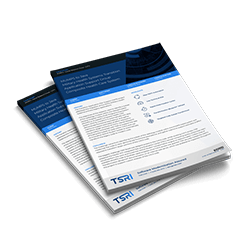 |
Customer: Retail Client Source & Target Language: COBOL to C# Lines of Code: 86,000 Duration: 3 months Services: Code Transformation, Automated Refactoring, Testing and Implementation Support, Transformation Blueprint®
|

